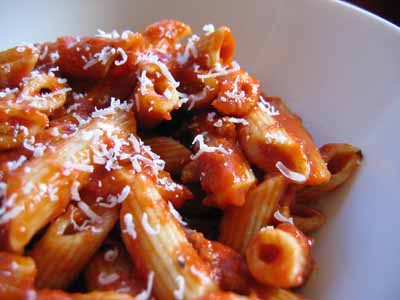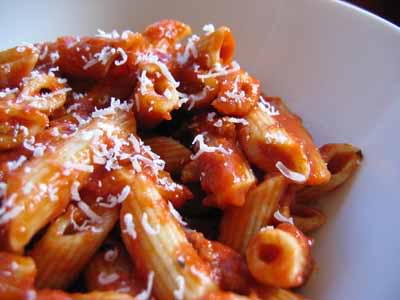
Today I’m delighted to introduce a guest writer, my husband S.
It’s known at “Little Gram’s Sauce,” after my mother’s maternal grandmother, a matriarch known by one and all by diminutive nickname. I’ve probably eaten more of this sauce than any other thing, except maybe water and milk. In fact, brands of spaghetti have come and gone (hell, so has the name: now it’s “pasta”) but the sauce has remained the same. With those credentials, I’m more qualified than my wife to write this, but compared to the rest of my family, I’m still a rookie. I don’t know much of the sauce’s history or evolution, but I bet my great-grandmother knows little, too. Not because she’s 102 and can’t remember, but because it probably existed in some form in her childhood and changed slightly and organically and very gradually over the next four generations.
It’s a sweet sauce. That’s key. Most importantly, it’s sweet because of what’s removed, NOT because of what’s added. The tartness of the tomatoes is removed through the magic of baking soda, as opposed to sweetness being added via sugar (which I’ve heard some people do—yuck!).
It’s a smooth sauce. That’s also crucial. Except for some pieces of meat or ground beef/pork/veal, it has a smooth consistency. Some herbs, onions finely chopped, garlic—not much else.
Sweet. Smooth. Elegant.
Ever since I hit my late teens and started to eat out more often, I’ve developed a theory about “the other sauces.” That would be anything that isn’t derived from Little Gram’s recipe: jarred, restaurant, sauce by friends. There’s typically something “American” about these sauces, which to me translates into spicy, chunky, and frequently crass. (I’ve come to label any tendency to shock or razzle-dazzle with an abundance of mis-matched spices as “American.” When in doubt, grab the oregano, basil, etc., and shake, shake, shake.) Anyway, I’ve always eaten pasta at restaurants, but I’ve never compared them to what I would have every Sunday growing up. Either the sauce stood on its own two feet or it didn’t. Most of all, it normally complemented the pasta, unlike Little Gram’s, which rendered the spaghetti a vehicle for her sauce.
Years ago, I tinkered with the recipe a bit. Not much. First it was ground turkey instead of ground beef/pork/veal. This is an obvious alteration since most of us don’t have the smoke-free, alcohol-free lifestyle that has allowed Little Gram to live to 102 and counting. Next it was adding a little red wine. It made it sweeter, but my brother was outraged. His reaction was sound, and before long, I reverted to the original.
In my mid-20’s, regardless of what office I worked in, I would regularly live off this stuff. I’d make a double batch and cook pasta in two day-increments. Then I’d take it into work and re-heat it for lunch. I had a reputation as the pasta guy, the Tupperware guy, or the smart guy (as in “You’re so smart to do that! You must save so much money!”). Before long, I’d circulate the recipe. One year, I gave my co-workers each a jar of sauce. I took a day off and made four batches!
Little Gram’s Sauce
Makes a double batch
3 T. olive oil
1 lg. onion, sliced and diced
12 cloves of garlic, minced fine
56 oz. tomato puree
36 oz. tomato paste
56 oz. water
pinch or two of baking soda
2 t. salt
2 T. dried basil
½ t. dried oregano
1 lb ground beef/pork/veal combo or turkey (optional)
Saute the onions in the olive oil. Cook til golden. Add garlic for a minute or so. Add paste, puree, & water and raise the heat. After sauce starts to boil, turn down the heat to simmer. Add the baking soda and stir in, which will cause the sauce to foam.

Remove foam with spoon. Add the remaining ingredients, crumbling the raw ground meat with your fingers as you add it in bits; cover and let simmer for 2 to 2 ½ hours, stirring occasionally. This will make a lot of sauce; I recommend freezing about 2/3 for later use.
NOTE: Sauce will thicken as it cooks. More water can be added if you prefer.

